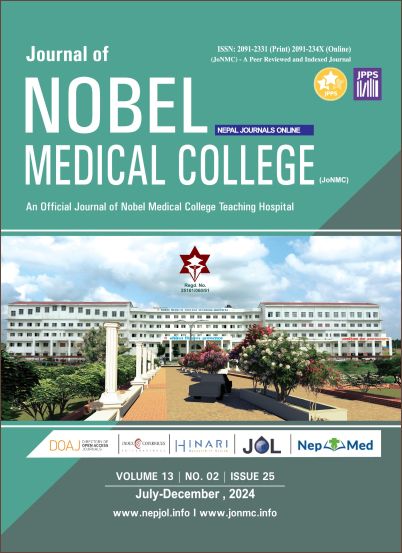Prevalence of Carbapenemase Producing Klebsiella Pneumoniae Causing Urinary Tract Infection in Patients Visiting Kathmandu Medical College
DOI:
https://doi.org/10.3126/jonmc.v13i2.74411Keywords:
Carbapenem-Resistant Enterobacteriaceae, Drug Resistance, Klebsiella pneumoniae, Urinary Tract InfectionAbstract
Background: Urinary tract infections are among the most common bacterial infections worldwide, with Klebsiella pneumoniae being the leading cause. This study was done to ascertain the prevalence of Multi drug resistance, Extended Spectrum Beta Lactamase and carbapenemase production among urinary Klebsiella pneumoniae isolates.
Materials and Methods: A descriptive cross-sectional study was done in a Kathmandu Medical College, Kathmandu, Nepal from March-September, 2024 after obtaining ethical clearance. Total 89 urinary Klebsiella pneumoniaeisolates were studied. Urine culture, isolation and identification of the isolates was done using standard microbiology techniques. Antibiotic susceptibility testing was performed by Kirby–Bauer disc diffusion method. Extended spectrum Beta lactamase producers were screened using ceftazidime and confirmed by ceftazidime (30μg) and ceftazidime plus clavulanic acid (30/10μg) disc. Carbapenemase producers were detected using modified carbapenem inactivation method. The data obtained were computed and analyzed using Statistical Package for Social Sciences 20.0 Version.
Results: Total 89(11.93%) Klebsiella pneumoniae were isolated from 743 urine sample. Among the isolates, 50 (56.17%) were multidrug resistant. Extended spectrum Beta lactamase detection by phenotypic confirmatory disc diffusion test identified 34 (38.20%) extended spectrum Beta lactamase producers. 21 (23.59%) were Meropenem resistant by Disc diffusion method while Carbapenemase production was confirmed in 6 (6.74%) isolates by Modified Carbapenem Inactivation method.
Conclusion: The present study concluded that multidrug resistance and Extended spectrum Beta lactamase production among uropathogenicKlebsiella pneumoniae is prevalent in our setting. The isolates producing carbapenemase were fewer but raises significant concern.
Downloads
Downloads
Published
How to Cite
Issue
Section
License
Copyright (c) 2024 The Author(s)

This work is licensed under a Creative Commons Attribution 4.0 International License.
JoNMC applies the Creative Commons Attribution (CC BY) license to works we publish. Under this license, authors retain ownership of the copyright for their content, but they allow anyone to download, reuse, reprint, modify, distribute and/or copy the content as long as the original authors and source are cited.




